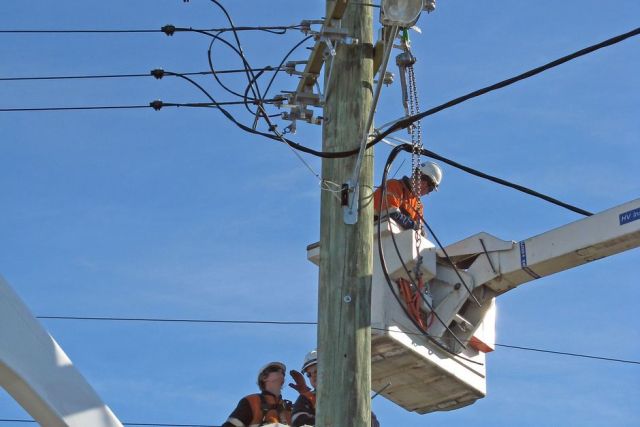
The rising pressures on the costs of living for Australian households, in particular caused by soaring electricity prices, will likely be a feature battleground in the September federal election.
The two big parties have long been scuffling over who is to blame for an issue that severely affects most Australian households and is a huge source of discontent as a result.
Liberal opposition leader Tony Abbott loves to blame the carbon price for savage power bills. Last September, fewer than three months after a so-called price on carbon pollution was introduced, he told the Today Show: “Now the carbon tax is not the only factor in price rises, but right now it’s at least 50% of price rises around Australia, 80% in western Sydney and almost 100% in Queensland.
“So, getting rid of the carbon tax is the best thing we can do to take the pressure off prices.”
Prime Minister Julia Gillard has been slightly more realistic about the culprit of high power costs. She has blamed the state governments for “demonstrable inefficiencies in the resource allocation of the market”.
Liberal frontbencher Malcolm Turnbull also agreed that “gold-plating” — or over-investment in poles and wires of the network — is “the bulk of the reason for the 50%”.
Abbott and Gillard hold government policies — the carbon price and the so-called inefficiencies of state-owned assets — responsible.
Neither has mentioned the fact that Labor and Liberal, state and federal, have been promising lower energy prices for the past two decades, yet the cost of electricity managed to rise 170% from March 1995 to 2012 — more than four times the overall climb in the consumer price index.
A report released last month by the Australia Institute said these promises to lower costs and raise services were the reasons given for the privatisation and corporatisation of many former state-owned energy assets.
The report, Electricity and privatisation: What happened to those promises?, analysed the effect on costs of splitting up, selling off and outsourcing formerly state-owned infrastructure and assets via progressive measures of deregulation and privatisation.
The report’s author, David Richardson, found that the electricity sector has experienced a long-term productivity slump and increased capital costs associated with the widespread “reforms” of the 1990s, which included large-scale sales to private firms and restructuring public firms to behave more like private corporations.
Richardson said: “Far from privatisation reducing costs it is likely it has contributed to price increases.”
A “dramatic fall in output per worker” accompanied a fall in productivity of 24.9% — explained in large part by a huge rise in the number of managers, professionals and workers operating exclusively in “sales and advertising”.
This has also meant that fewer workers overall are operating as “technicians and trades workers”, who are the frontline workers that actually deliver services.
The report says: “It is likely that this change in the sector’s employment structure is a consequence of privatisation and the split of electricity entities into much smaller units, each requiring its own management and administration team.”
Similarly, the increasing reliance on the market and the need to win customers through advertising wars led to a 500% rise in sales workers — from 1000 sales workers across the electricity, gas, water and waste services in August 1995 to 6000 in August 2012.
Monopoly sectors such as electricity — that is, a sector that provides a product universally required by everyone — are valuable assets. So, the Australia Institute report says, private buyers will “pay a good deal more than the value of the plant and equipment is worth because the business has the potential to earn monopoly or near-monopoly profits.”
When governments sell off their assets, buyers will often borrow huge amounts to make the winning bid — the report calls this “asset value inflation”.
This means that, in addition to depreciation costs, there are added costs of interest and of course the company’s desire to begin earning profits as fast as possible.
Dividing entities, carving off sections of the industry, employing more managers and sales workers, and the huge outlay of acquiring the capital, are all costs that are passed onto consumers through higher electricity prices.
This is because private companies don’t buy up such valuable and socially necessary assets so that they can run them more efficiently and provide reduced costs for consumers. They do it for profits.
Despite this, growing dissatisfaction with rising costs and deteriorating services in the electricity sector is being met with increasing calls to privatise the industry in states where it has not already been done.
Former federal treasurer Peter Costello, in an audit report ordered by the Queensland government seeking to reduce its debt, recommended a $10 billion sale of the state’s electricity transmission network.
The former NSW Labor government sold off the retail sector in 2011, and Barry O’Farrell has been encouraged by his advisors and private vested interests to sell off the generators, relying on growing discontent with its deteriorating state-run system.
But Australia’s energy system was built on public investment and has grown inefficient and expensive through neglect and unwillingness by governments to oppose corporate interests.
The energy sector should be put back into public hands, and overseen by workers, unions and community bodies. Rather than build new gas or coal-fired power stations for private companies to run for profit, an energy sector run in the interests of people — and, most importantly, the environment and planet —would invest in renewable power, energy-efficient homes and more jobs and services.